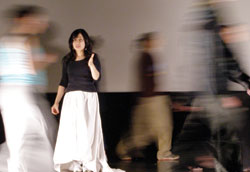Per/Son/Alia: bureaucratic beauty

Paula Cardenas was among the performers at the collaborative performance between the theatre and music departments.
Katie-Jean wall
A surprising amount of paper work was involved in attending Per/Son/Alia, a collaboration between Concordia’s Theatre and Music Departments.
Directed by Canada Research Chair for Inter-X Arts Sandeep Bhagwati, the production promised to explore the conflict between bureaucratic and mythological definitions of identity. So you couldn’t say they didn’t warn you.
Presenting my photo ID and carefully filled out security form, I expect to get my ticket, but no, I must go to the complaints desk. A security guard (Lindsay Wilson) snaps her gum, appraises my form and raises her eyebrows. I have failed to note my middle name.
Several corrections and several lineups later — my coat checked, identity tag around my neck — I am led into a small room filled with a symphonic racket of clacking typewriters (the work of composer Joel Corriveau) and baleful-eyed bureaucrats.
The last of these (Stephanie Merulla) takes my papers. “Your handwriting is atrocious,” she intones. One by one, she shreds them.
The play’s conceit is that we are in a theatre and a power outage has delayed the performance. (Yet that guard at the complaints desk was from Charon Security. . .) The actors will entertain us while we wait.
In commedia dell’arte masks and fanciful costumes (combinations of ultra theatrical, glitzy fabrics and modern, rubbery plastics by Azra King-Abadi) they perform vaudevillian musical numbers and comic/tragic monologues inspired in part by personal monologues performers submitted during their auditions.
Cruelly, the most traumatic story belongs to the most innocent character, played by Krystelle Metras. Her bubble-wrap skirt suits her bubbly persona, but offers no protection from a shattering sexual assault that is performed with brutal directness.
Sitting on stage, watching with the audience, some performers pull their masks down or look away, demonstrating, intentionally or not, how hard it is to mask personal feelings in the face of another’s pain. Is this the most fundamental form of identification? Is our personal reaction to the cathartic power of theatre our best ID?
Of the sexual assault scene actor Koralie Deetjen-Woodward later affirms, “We (the actors) can’t help but react to it.” It was “the most unsettling experience, but beautiful.” In fact, every day of the collaborative process that led to the performance brought “something new and personal.”
“The power is back!” The actors rush to take their places and darkness descends.
The sound of lapping water transforms the theatre into the River Styx, and we are led into a womb-like enclosure of red-lit canvas, where a recorded voice describes a nightmare that only stopped once it was understood as a memory of being born, or led towards Earth. Lucian Mills’ contemporary music score (sung by Nancy Helms, Brian McMillan and Charlotte Cumberbirch) builds to an uncomfortable volume.
When the music stops, the canvas panels lift, and there are our coats, plastic-wrapped and tagged with our ID numbers.
Outside, we are welcomed to a jubilantly macabre marketplace, the work of props designer Anahita Dehbonehie. “Tongues! Teeth!” sings one huckster. False legs and feet are displayed; rubbery tongues protrude from a battered suitcase.
The actors impishly foist alternate body parts on participants (a young woman smiles weakly, firmly shaking her head as one rubbery ear after another is pressed against her own). We are all happy with our originals, thank you very much.
Cathartic and playful, it was a creative and technical workout for all concerned. Waiting for the bus is so pleasurably simple I forget to be impatient, and what would have been a hellishly long wait is downright heavenly.